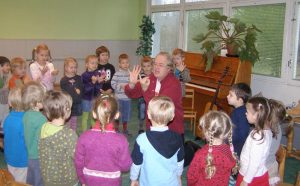Presenting New Language Through Action Songs
As long ago as 1968, the language expert and author Julian Dakin wrote: “If songs and rhymes are well taught, they are seldom forgotten. They are particularly useful for practising the sound systems of the language and learning vocabulary. Learners can gain fluency and control over new material which can then be drawn into everyday usage.”
Dakin is absolutely right! And if we add dance and mime taught through TPR techniques, we have the language-learning action song module – in my experience the fastest and most effective method of presenting, teaching and practising new language.
Before presenting the new song to her class, the teacher should familiarise herself with the words and teaching actions. Teaching actions videos such are particularly useful for this. Click to see an example of “Water is Everything”.
Here are several reasons why action songs are such effective teaching tools.
Motivating
Action songs are fun! Learners immediately have a reason for taking part whole-heartedly in the activity. Once everyone in the class can sing and mime the song, you can use its language and themes as the starting point of a new teaching module.

Multi-intelligent
Learning through action songs brings several intelligences “online” at the same time: musical, linguistic, spatial and visual. This reinforces and accelerates the learning process.
Emotional
Good songs are underpinned by the expressive and engaging power of music and
Verse, producing an emotional charge. This again facilitates learning and guarantees attention.
Unforgettable
Learning new vocabulary in an action song sets up a rich gamut of hooks in the learner’s memory. Since the sound – and meaning – of the words and phrases in the action song is wedded to the melody and rhythm in a dynamic activity, learners experience PMA (Permanent Memory Acquisition).
Phonological
You can’t sing a song unless you pronounce its lyrics properly. With its schwas and accented phonemes, English has a sound system that lends itself particularly well to rhymes, chants and songs. As the sounds that make up an utterance can be compared to the single notes of a melody, singing in English helps students acquire correct pronunciation.
Psychological
The gratifying act of singing and performing a collective action song in English gives children a strong sense of achievement and confidence.
Presentative
Action songs should be used to present new language. Once the children know the song, its language can be recycled and reworked in other communicative contexts. This is why it’s important to choose action songs such as “The Monster March” with useful, relevant lyrics.
Which songs?
Here are some points to consider when choosing, writing – and teaching – through language-learning action songs.
Strong tunes and rhythms
Songs and music are nothing special for young learners – thanks to gadgets, smartphones and tablets they have access to recorded music from an early age! So in order to work, language-learning action songs must stand up as valid and attractive musical creations in themselves, catchy songs that the children want to learn. Banal, recycled tunes and routines may risk alienating some learners.
Language and song theme
The presentative lyrics of the action song should not contain an excessive amount of difficult words and phrases. For example choreographing and teaching Jingle Bells is a waste of time as it contains many words you probably won’t be using in your syllabus.
You want to pick songs about aspects of life that are important to and interesting for your students. Obvious themes that come to mind are colours, numbers, the seasons, nature, school, Christmas, Easter, Halloween, food, monsters, animals, family and parts of the body.
Mime and meaning chunks
Action songs should be taught through their meaning gestures, never from a print-out of the lyrics. Your class should not see the lyrics in written form until they know the song by heart. Depending on the competence of your class, limit the use of L1 if possible. The meaning gestures should be simple and direct (such as pointing both fingers upwards in time with the music to indicate “the sky is blue” ). Their value lies in the association each child’s mind makes between the sound of the chunk and its meaning. Action songs should be taught in a sequence of meaning chunks – on a two-steps forward one-step back basis. TPR techniques in which the students carry out actions are extremely useful in the learning stage.
Activities and exercises
Rather than simplistic gap-fills, why not do activities that encourage the students to use the song’s content in different ways. One activity that always works is eliciting. Here you invite the children to form pairs. Student A performs a gesture from the action song and Student B must say which meaning chunk of the song it refers to. Reading, writing and interactive whiteboard activities should be based on illustrations, multiple choice answers, crosswords, and word games.
Performances and theatre
One of the great things about action songs is that they will be remembered and can be sung time and time again. Most children love performing – using action songs in a show for parents or other classes in the same school is always worthwhile. Knowing the song is going to be performed will give the child a greater sense of purpose and make teaching – and learning – easier. FunSongs Education stages special FunSongs puppet and action song shows. See www.funsongs.co.uk for further details.
Accessing action songs on the internet
Although websites and YouTube are full of videos and songs for learning English, there are surprisingly few quality providers of language-learning action song modules for teachers of English to young learners. My website FunSongs Education, nominated for an ELTons award, provides schools and teachers with action song packages on a range of vocabulary areas.




